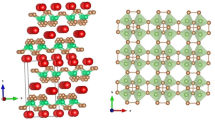Abstract
For the first time, a molecular dynamics simulation study has been performed for a liquid metal system consisting of 50000 atoms to deeply investigate the transitions of microstructure configurations during the rapid cooling processes. Especially, the cluster-type index method has been adopted to analyze the transforming and evolving processes of clusters and cluster configurations from liquid metal atoms. It has been found that the bigger cluster configurations in the system are formed by means of connecting some small clusters (they are combined by several smaller clusters), and not taken on the multi-shells configuration accumulated with an atom as the center and the surrounding atoms arranged according to some fixed pattern. With the decrease in temperature, the probability of repetitive appearance for clusters increases largely, which reveals that clusters are indeed possessing a certain relative stability and continuity ( namely hereditary effect). These results will give us an important enlightenment to understand not only the forming mechanisms and microscopic processes of the short-order sections and disorder sparse seiions in amorphous structures but also the freezing processes of liquid metals.
Similar content being viewed by others
References
Lu, J., Szpunar, J. A., Molecular-dyiiamics simulation of rapid solidification of aluminum, Acta Metall. Mater., 1993, 41 (8): 2291–2295.
Stepanyuk, V. S., Szasz, A., Katsnelson, A. A. et al., Microstructure and its relaxation in Fe- B amorphous system simulated by molecular dynamics, J. Non-Crystalline Solids, 1993, 159: 80–87.
Tsay, S. F., Relation between the B and rapidly quenched liquid phases of gallium, Phys. Rev. B, 1994, 50(1): 103–107.
Liu, C. S., Zhu, Z. G., Xia, J. C. et al., Different cooling rate dependences of different microstructure units in A1 glass by molecular dynamics simulation, Chin. Phys. Lett., 2000, 17(1): 34–36.
Liu, R. S., Qi, D. W., Wang, S., Subpeaks of structure factors for rapidly quenched meters, Phys. Rev. B, 1992, 45: 451–453.
Liu, R. S., Wang, S., Anomalies in the structure factor for some rapitlly quenched metals, Phys. Rev. B, 1992, 46: 12001 - 12003.
Liu, R. S., Li, J. Y., Zhou, Z. et a1., The high-temperature properties of the microstructure transition in liquid metals, Mater. Sci. Eng. B, 1999, 57: 214–217.
I.i, J. Y., I.iu, R. S., Zhou, Z. et al., Mirostructural transitions during the rapid cooling process of liquid metal Al, J. Mater. Sci. Tech., 1998, 14: 461–464.
Liu, R. S., Li, J. Y., Zhou, Z. et a1., The stability of microstructures during rapid cooling processes of A1 liquid metal, Trans. Nonferrous Met. Soc. China, 1998, 8: 533–538.
Liu, R. S., Li, J.Y.,Du, H.Q.,A simulation study on the transition process of amorphous structure of Gallium, Chinese Science Bulletin, 1993, 38(22): 1861–1865.
Liu, R. S., Li, J. Y., Zhou, Q. Y., A simulation study on the transition feature of the microstructure in the forming processes of amorphous metals, Chinese Science Bulletin, 1995, 40(17): 1429–1433.
Wang, S., Lai, S. K., Structure and electrical resistivities of liquid binary alloys, J. Phys. F, 1980, 10:2717–2737.
Li, D. H., Li. X. R., Wang, S., Variational calculation of Helmholtz free energies with applications to the sp-type liquid metals, J. Phys. F, 1986, 16: 309–321.
Honeycutt, J. D., Andersen, H. C., Molecular-dynamics study of melting and freezing of small Lennard-Jones Clusters, J. Phys. Chem., 1987, 91: 4950–4963.
Qi, D. W., Wang, S., Icosahedral order and defects in metallic liquids and glasses, Phys. Rev. B, 1991, 44: 884–887.
Waseda, Y., The Structure of Non-crystalline Materials, New York: McGraw-Hill, 1980, 270.
Martin, T. P., Naher, U., Schaber, H., Evidence for octahedral shell structure in aluminum clusters, Chem. Phys. Lett., 1992, 199(5): 470–474.
Bmyer, M., Metallic character of small metal aggregates as a function of their atomic structure, Non-Crystalline Solids, 1993, 156-158: 787–793.
Author information
Authors and Affiliations
Corresponding author
Rights and permissions
About this article
Cite this article
Zheng, C., Liu, R., Dong, K. et al. Simulation study on the formation and transition properties of cluster structures in liquid metals during rapid cooling processes. Sci. China Ser. A-Math. 45, 233–240 (2002). https://doi.org/10.1360/02ys9024
Received:
Issue Date:
DOI: https://doi.org/10.1360/02ys9024




